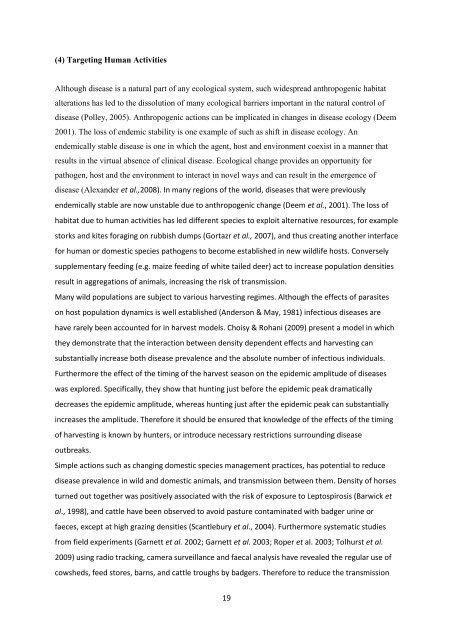Developing an oral bait for badger vaccination - Exeter Research ...
Developing an oral bait for badger vaccination - Exeter Research ...
Developing an oral bait for badger vaccination - Exeter Research ...
You also want an ePaper? Increase the reach of your titles
YUMPU automatically turns print PDFs into web optimized ePapers that Google loves.
(4) Targeting Hum<strong>an</strong> Activities<br />
Although disease is a natural part of <strong>an</strong>y ecological system, such widespread <strong>an</strong>thropogenic habitat<br />
alterations has led to the dissolution of m<strong>an</strong>y ecological barriers import<strong>an</strong>t in the natural control of<br />
disease (Polley, 2005). Anthropogenic actions c<strong>an</strong> be implicated in ch<strong>an</strong>ges in disease ecology (Deem<br />
2001). The loss of endemic stability is one example of such as shift in disease ecology. An<br />
endemically stable disease is one in which the agent, host <strong>an</strong>d environment coexist in a m<strong>an</strong>ner that<br />
results in the virtual absence of clinical disease. Ecological ch<strong>an</strong>ge provides <strong>an</strong> opportunity <strong>for</strong><br />
pathogen, host <strong>an</strong>d the environment to interact in novel ways <strong>an</strong>d c<strong>an</strong> result in the emergence of<br />
disease (Alex<strong>an</strong>der et al.,2008). In m<strong>an</strong>y regions of the world, diseases that were previously<br />
endemically stable are now unstable due to <strong>an</strong>thropogenic ch<strong>an</strong>ge (Deem et al., 2001). The loss of<br />
habitat due to hum<strong>an</strong> activities has led different species to exploit alternative resources, <strong>for</strong> example<br />
storks <strong>an</strong>d kites <strong>for</strong>aging on rubbish dumps (Gortazr et al., 2007), <strong>an</strong>d thus creating <strong>an</strong>other interface<br />
<strong>for</strong> hum<strong>an</strong> or domestic species pathogens to become established in new wildlife hosts. Conversely<br />
supplementary feeding (e.g. maize feeding of white tailed deer) act to increase population densities<br />
result in aggregations of <strong>an</strong>imals, increasing the risk of tr<strong>an</strong>smission.<br />
M<strong>an</strong>y wild populations are subject to various harvesting regimes. Although the effects of parasites<br />
on host population dynamics is well established (Anderson & May, 1981) infectious diseases are<br />
have rarely been accounted <strong>for</strong> in harvest models. Choisy & Roh<strong>an</strong>i (2009) present a model in which<br />
they demonstrate that the interaction between density dependent effects <strong>an</strong>d harvesting c<strong>an</strong><br />
subst<strong>an</strong>tially increase both disease prevalence <strong>an</strong>d the absolute number of infectious individuals.<br />
Furthermore the effect of the timing of the harvest season on the epidemic amplitude of diseases<br />
was explored. Specifically, they show that hunting just be<strong>for</strong>e the epidemic peak dramatically<br />
decreases the epidemic amplitude, whereas hunting just after the epidemic peak c<strong>an</strong> subst<strong>an</strong>tially<br />
increases the amplitude. There<strong>for</strong>e it should be ensured that knowledge of the effects of the timing<br />
of harvesting is known by hunters, or introduce necessary restrictions surrounding disease<br />
outbreaks.<br />
Simple actions such as ch<strong>an</strong>ging domestic species m<strong>an</strong>agement practices, has potential to reduce<br />
disease prevalence in wild <strong>an</strong>d domestic <strong>an</strong>imals, <strong>an</strong>d tr<strong>an</strong>smission between them. Density of horses<br />
turned out together was positively associated with the risk of exposure to Leptospirosis (Barwick et<br />
al., 1998), <strong>an</strong>d cattle have been observed to avoid pasture contaminated with <strong>badger</strong> urine or<br />
faeces, except at high grazing densities (Sc<strong>an</strong>tlebury et al., 2004). Furthermore systematic studies<br />
from field experiments (Garnett et al. 2002; Garnett et al. 2003; Roper et al. 2003; Tolhurst et al.<br />
2009) using radio tracking, camera surveill<strong>an</strong>ce <strong>an</strong>d faecal <strong>an</strong>alysis have revealed the regular use of<br />
cowsheds, feed stores, barns, <strong>an</strong>d cattle troughs by <strong>badger</strong>s. There<strong>for</strong>e to reduce the tr<strong>an</strong>smission<br />
19
















